 W
WThe Eighteenth Dynasty of Egypt is classified as the first dynasty of the New Kingdom of Egypt, the era in which ancient Egypt achieved the peak of its power. The Eighteenth Dynasty spanned the period from 1549/1550 to 1292 BC. This dynasty is also known as the Thutmosid Dynasty for the four pharaohs named Thutmose.
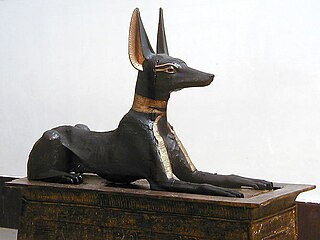 W
WThe Anubis Shrine was part of the burial equipment of the 18th Dynasty pharaoh Tutankhamun. His tomb was discovered almost intact on 4 November 1922 in the Valley of the Kings in west Thebes by Howard Carter. Today the object, with the find number 261, is on display at the Egyptian Museum in Cairo, with the inventory number JE 61444.
 W
WThe Bronze Sphinx of Thutmose III is a statuette of a sphinx made during the 18th Dynasty of Egypt under the reight of Thutmose III, who ruled from c. 1479 to 1425 BCE. Adorned with multiple symbols of royal power, it might have been an element or a lock. It was purchased by the Louvre in 1826, and is part of the permanent collections in the display case 4 in Room 637, Sully Wing, first floor.
 W
WDuring the reign of the ancient Egyptian pharaoh Amenhotep III hundreds of so-called memorial scarabs were issued to commemorate the deeds of the pharaoh. Such scarabs were found in several archaeological sites of the Near East, from Syria to Sudan. Over two hundred of them are known to exist in museums and collections around the world.
 W
WThe Dream Stele, also called the Sphinx Stele, is an epigraphic stele erected between the front paws of the Great Sphinx of Giza by the ancient Egyptian pharaoh Thutmose IV in the first year of the king's reign, 1401 BC, during the 18th Dynasty. As was common with other New Kingdom rulers, the epigraph makes claim to a divine legitimisation of kingship.
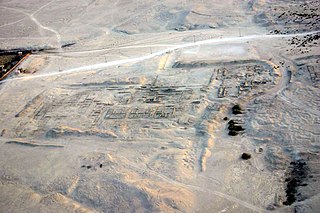 W
WMalkata, meaning the place where things are picked up in Arabic, is the site of an Ancient Egyptian palace complex built during the New Kingdom, by the 18th Dynasty pharaoh Amenhotep III. It is located on the West Bank of the Nile at Thebes, Upper Egypt, in the desert to the south of Medinet Habu. The site also included a temple dedicated to Amenhotep III's Great Royal Wife, Tiy, which honors Sobek, the crocodile deity.
 W
WThe Painting of Lady Tjepu is a fragment from a large fresco from Tomb 181 in Thebes (Luxor). It dates to the 18th Dynasty reign of Pharaoh Amenhotep III.
 W
WThe Pharaoh Who Conquered the Sea is a 2010 British documentary film produced by the BBC. The film premiered on BBC Four on 6 January 2010, and is presented by archaeologist Cheryl Ward and directed by Stephane Begoin. Chris Hilton and Valerie Abita served as the executive producers. The duration of the film is fifty nine minutes.
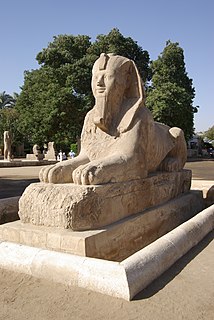 W
WThe Sphinx of Memphis is a stone sphinx located near the remains of Memphis, Egypt. The carving was believed to take place between 1700 and 1400 BC, which was during the 18th Dynasty. It is unknown which pharaoh is being honored and there are no inscriptions to supply information. The facial features imply that the Sphinx is honoring Hatshepsut or Amenhotep II or Amenhotep III.
 W
WThe Stela of Tetisheri is a limestone donation stele erected by Pharaoh Ahmose I, founder of the Eighteenth Dynasty of Egypt. It sits in the construction of his mortuary complex that included a cenotaph to his grandmother Queen Tetisheri, Senakhtenre's Great Royal Wife and grandmother of both Ahmose and his Principal Wife, Ahmose-Nefertari.
 W
WThe Throne of Princess Sitamun is an artefact from the tomb of Yuya and Tjuyu, which belonged to their granddaughter, Princess Sitamun, the daughter of Pharaoh Amenhotep III and Queen Tiye of the 18th Dynasty.
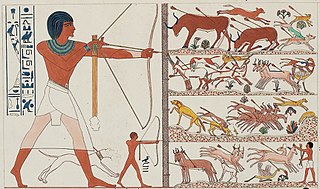 W
WTomb A.5 is the modern number given to a now lost Theban tomb in Dra' Abu el-Naga'.. The burial dates to the Ancient Egyptian 18th Dynasty and belonged to the overseer of the granary of the Lord of the Two Lands, Neferhotep. The tomb was visited by the French traveller Frédéric Cailliaud, who copied and published several scenes. Evidently, he saw the tomb in a fairly good condition and was described by others as superb. The location of the tomb got lost within the Nineteenth century. According to the old drawings published., there are several scenes depicted in the tomb. These include hunting in the marshes, hunting in the desert, banquet scenes, vintage and agriculture and including a scene of making wine.
 W
WTomb A.6 is the modern number given to a now lost Theban tomb in Dra' Abu el-Naga'. The burial dates to the ancient Egyptian 18th Dynasty and belonged to the overseer of the marshland dwellers Dhjehutinefer, who is also called Seshu. The place was visited by the expedition of Karl Richard Lepsius, who copied the tomb owner's title overseer of the marshland dwellers of the lord of the two lands, but not the name. It seems that the tomb was then already heavily destroyed. Before 1906 the French Egyptologist Henri Gauthier visited A.6 and described the few remains of the decoration and published a short note. Gauthier recorded some further titles of Dhjehutinefer, such as scribe and counter of cattle and fowl of the temple of Amun. A fragment belonging to the tomb is a wall painting that is today in the Metropolitan Museum in New York. On the fragment in New York also mentioned the wife of Djehutinefer, a woman called Benbu. Several funerary cones belonging to the tomb are known. They provide the name of Djehutynefer's father who was the scribe Mesu.
 W
WTomb A.24 is the modern number given to a now lost Theban tomb in Dra' Abu el-Naga'. The burial dates to the ancient Egyptian 18th Dynasty and belongs to the second priest of Amun Simut. The tomb was already known in the early 19th century and was visited by several early travelers, such as Jean-François Champollion and John Gardner Wilkinson. Especially the latter made several copies of the painted decoration. He seems to have seen the tomb in a fairly good state of preservation while it was already more destroyed when Jean-François Champollion came later. He copied some inscriptions. Several scenes can reconstructed from these early accounts. There was a depiction showing the family of Simut receiving offerings, most likely in connection with a festival, called the Valley festival. A second scene shows the family of Simut hunting in the marshes. The scene was drawn by John Gardner Wilkinson and later published by him. A third scene must have shown vintage. Wilkinson only copied a small detail. Another scene seems to have shown Simut in front of scribes, men weighing and Nubians bringing tribute. The scene most likely relates to the office of Simut, who most likely also looked after the magazines of the Temple of Amun in Karnak.
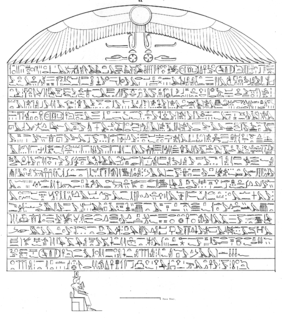 W
WThe Tombos Stela is an ancient Egyptian rock inscription found in the area of Tombos (Nubia), dated to Year 2 of Pharaoh Thutmose I. It attests to his military campaign into Nubia around the area of the 3rd cataract of the Nile. It was discovered around 1829, on a large boulder in Tombos, Nubia on the east bank of the Nile. Thutmose is known to have expanded Egypt’s borders throughout his reign, not only in Nubia, but also by campaigns in the Syria-Palestine area. During the Middle Kingdom, pharaohs such as Mentuhotep II had already expanded into Nubia. However, scholars argue that the Tombos stela is evidence of farther expansion by Thutmose into Nubia than previous kings.
 W
WThe Theban Tomb TT45 is located in Sheikh Abd el-Qurna, part of the Theban Necropolis, on the west bank of the Nile, opposite modern Luxor. It was originally the burial place of the ancient Egyptian named Djehuty (Thoth), who was a scribe of the offering-table of Mery, high-priest of Amun, head of all the weavers of Amun, and steward of Mery, high priest of Amun. Djehuty lived during the reign of Amenhotep II. He was the son of a lady also named Djehuty.
 W
WUrkunden des ægyptischen Altertums is a series of editions of Ancient Egyptian texts, published between 1903–1961.